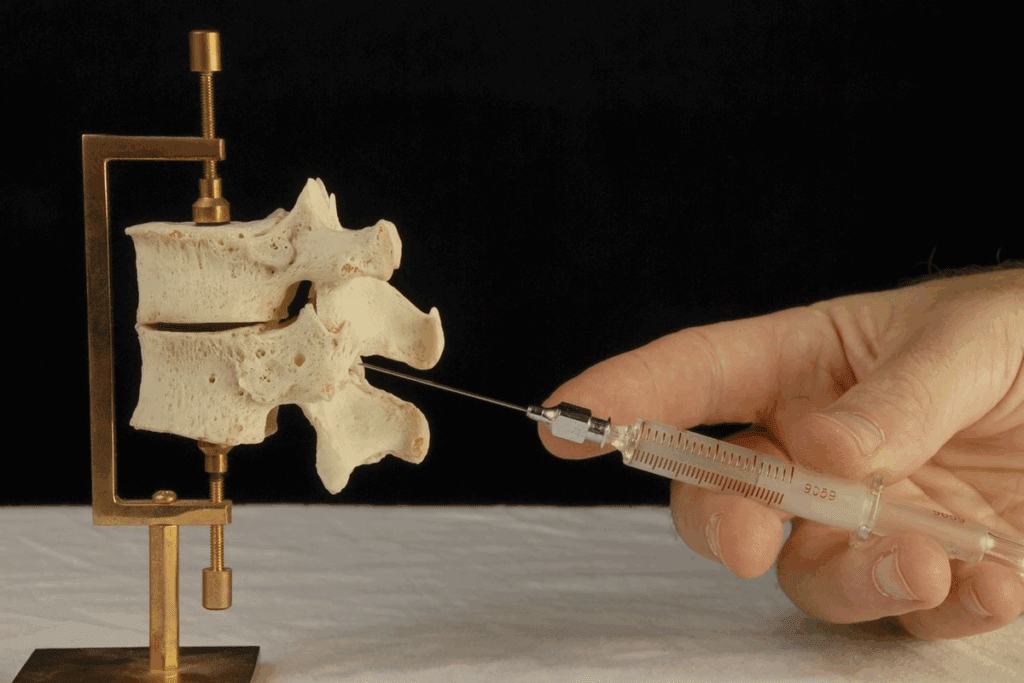Last Updated on November 26, 2025 by Bilal Hasdemir

At Liv Hospital, we know how tough it can be to deal with back or leg pain. We’re here to offer top-notch, ethical, and patient-centered care. A lumbar epidural steroid injection (LESI) is a non-surgical way to help with lower back and leg pain. It puts corticosteroids right into the area around the spinal nerves in your lower back.
This method is often used for different spinal issues, like pain that spreads down your leg. The Illinois Pain Institute says a lumbar epidural steroid injection can help by cutting down on swelling around the nerves.
Key Takeaways
- Lumbar Epidural Steroid Injection (LESI) is a non-surgical treatment for lower back and leg pain.
- LESI involves injecting corticosteroids into the epidural space around the lumbosacral spinal nerves.
- This procedure is used to treat various spinal conditions, including radiating low back pain.
- Corticosteroids reduce inflammation around the spinal nerves, providing pain relief.
- LESI is typically administered in a series of up to 3 injections, spaced at least two weeks apart.
LESI Medical Abbreviation: Definition and Overview

LESI stands for Lumbar Epidural Steroid Injection. It’s a treatment for pain in the lower back and legs. Corticosteroids are injected into the epidural space around the spinal cord. This helps patients with different lumbar spine issues.
What LESI Stands For in Medical Terminology
In medical terms, LESI means Lumbar Epidural Steroid Injection. This treatment focuses on the lumbar spine, where many back problems happen. Knowing what LESI is helps patients understand their treatment choices better.
Relationship Between LESI and ESI Medical Abbreviations
LESI is related to ESI, which is Epidural Steroid Injection. ESI can be in any spine area, but LESI targets the lumbar region. This shows LESI is more specific, aiming at lower back pain and inflammation.
“Epidural steroid injections are a common treatment for back pain, and when targeting the lumbar region, they’re called LESI.” – A medical professional’s insight into the importance of precise terminology in pain management.
The Purpose of Lumbar Epidural Steroid Injections
LESI aims to reduce inflammation and pain in the lower back and legs. The Medical organization says epidurals are injections near the spinal cord for pain relief or anesthesia. By injecting corticosteroids into the epidural space, LESI helps patients with herniated discs, spinal stenosis, and sciatica.
It’s key for patients to understand LESI to make informed treatment choices. Knowing LESI’s definition and purpose helps patients talk better with their doctors and decide on their care.
Anatomy of the Spine and Epidural Space

To understand Lumbar Epidural Steroid Injections (LESI), we need to know about the lumbar spine and epidural space. The spine has vertebrae, discs, and nerves. These parts are key to LESI’s success.
The Lumbar Spine Structure
The lumbar spine is in the lower back and has five vertebrae (L1-L5). It supports a lot of weight and allows for movement. Knowing the lumbar spine structure helps us see how LESI works, focusing on L4-L5 and L5-S1.
Understanding the Epidural Space
The epidural space is outside the sac with spinal fluid and nerves. It’s where LESI puts corticosteroids to fight inflammation and pain. Injecting into the epidural space helps treat pain from herniated discs and spinal stenosis.
Key Nerve Roots: L4, L5, and S1
Nerve roots L4, L5, and S1 are key because they often cause lower back and leg pain. L4-L5 and L5-S1 are key for LESI because they’re common pain spots. Knowing these nerve roots and their location is important for LESI’s success.
Conditions Treated with LESI Procedures
We use LESI injections to treat many conditions in the lumbar spine. These injections help reduce inflammation and improve mobility. They are effective for patients with various spinal disorders.
Herniated Discs and Nerve Compression
A herniated disc happens when the soft inner gel leaks out. This can compress nerves and cause pain, numbness, and weakness. LESI targets the inflamed area, reducing swelling and relieving nerve pressure.
Spinal Stenosis
Spinal stenosis is when the spinal canal narrows. This puts pressure on the spinal cord and nerves. LESI injections can reduce inflammation and swelling, helping to alleviate symptoms.
Sciatica and Radiculopathy
Sciatica is pain that runs along the sciatic nerve. Radiculopathy includes pain, numbness, and weakness from nerve compression. LESI is often used to treat these conditions, helping when a herniated disc or spinal stenosis compresses a nerve.
Degenerative Disc Disease
Degenerative disc disease occurs when discs lose height and integrity. This can cause pain and inflammation. LESI injections can manage pain and inflammation, improving life quality.
Doctors often recommend epidural injections for sciatica caused by a herniated disc or spinal stenosis. Understanding what LESI can treat helps patients make better care choices. It may help them avoid more invasive surgeries.
Types of Lumbar Epidural Steroid Injections
It’s important for doctors to know about the different types of Lumbar Epidural Steroid Injections (LESI). This helps them choose the best treatment for their patients.
LESI injections come in various forms. Each one is designed for specific spinal problems and patient needs. The type of injection depends on where the nerve is affected and the patient’s health.
Interlaminar Epidural Steroid Injection (ILESI Procedure)
The Interlaminar Epidural Steroid Injection (ILESI) is a common method. It delivers medication into the epidural space through the interlaminar space. This is good for treating central disc herniations or symptoms on both sides.
Transforaminal Epidural Steroid Injection (TFESI)
Transforaminal Epidural Steroid Injection (TFESI) targets the specific nerve root. It injects the steroid medication directly into the neural foramen. The TFESI medical abbreviation is used in medical records and literature for this precise technique.
Caudal Epidural Steroid Injection
The Caudal Epidural Steroid Injection involves injecting medication through the sacral hiatus. This method is useful for lower lumbar or sacral problems. It’s a good option when other methods can’t be used.
Understanding each type of LESI helps doctors tailor treatments. This approach can lead to better pain relief and a better quality of life for patients.
Targeted Injections: L4-L5 and L5-S1 Epidural Steroid Injections
Targeted epidural steroid injections at L4-L5 and L5-S1 levels help with lower back pain and sciatica. They aim at specific nerve roots that are inflamed or irritated. This method offers a direct way to manage pain.
L4-L5 Lumbar Epidural Steroid Injection: Indications and Technique
The L4-L5 level often faces spinal problems like herniated discs and degenerative disc disease. An L4-L5 lumbar epidural steroid injection is for those with radicular pain or neurological symptoms from nerve compression.
To perform the injection, doctors use fluoroscopic guidance to place the needle correctly in the epidural space at L4-L5. After confirming the needle’s position, a mix of corticosteroid and local anesthetic is given. This reduces inflammation and eases pain.
L5-S1 Epidural Steroid Injection: When It’s Recommended
L5-S1 epidural steroid injections are for symptoms related to the S1 nerve root, like sciatica or radiculopathy. This area is also at risk for herniated discs and foraminal stenosis, making targeted injections a good treatment.
The procedure for L5-S1 injections is similar to L4-L5, with fluoroscopy guiding the needle’s placement. The goal is to get the corticosteroid as close as possible to the affected nerve root for maximum effect.
S1 Injection: Specific Applications
S1 nerve root injections are great for diagnosing and treating S1 radiculopathy. The S1 nerve root controls muscles and sensations in the lower legs. Irritation or inflammation here can cause a lot of pain and discomfort.
The S1 injection targets the S1 nerve root with corticosteroid and local anesthetic. It not only relieves pain but also helps find the pain’s source when other tests are unclear.
| Injection Level | Common Indications | Technique |
| L4-L5 | Herniated discs, degenerative disc disease | Fluoroscopy-guided needle placement |
| L5-S1 | Sciatica, radiculopathy, foraminal stenosis | Fluoroscopy-guided needle placement |
| S1 | S1 radiculopathy, lower extremity pain | Targeted S1 nerve root injection |
The LESI Injection Procedure: Step by Step
Learning about the LESI procedure can ease worries for those thinking about it for back pain. The LESI injection is a detailed medical process. It includes several steps from start to finish, aiming to put corticosteroids in the epidural space to lessen pain and swelling.
Pre-Procedure Preparation and Evaluation
Before a LESI injection, patients get a detailed check-up. This includes looking over their medical history and current symptoms. This helps decide if the LESI injection is right for them. They also get advice on what to do before the procedure, like changing medications or arriving on time.
Patients must sign an informed consent form before the procedure. This is after talking about the possible risks and benefits with their doctor. It’s important for patients to know what the procedure is about.
Fluoroscopy-Guided Needle Placement
The LESI injection uses fluoroscopy, a live X-ray, to guide the needle into the epidural space. This makes sure the corticosteroid medicine goes exactly where it’s needed, making the treatment more effective.
During the procedure, the patient lies on their stomach. The skin where the needle will go is cleaned and numbed. The doctor uses fluoroscopy to guide the needle into the epidural space, sometimes using contrast dye to check the needle’s position.
Medication Delivery Process
After the needle is in the right spot, a mix of corticosteroid and local anesthetic is given. The corticosteroid reduces swelling, and the anesthetic eases pain right away.
The doctor watches closely to make sure the right amount of medicine is given. Fluoroscopy lets them see in real-time, so they can adjust the needle if needed.
Duration and Immediate Post-Procedure Care
The LESI injection procedure usually takes 15 to 30 minutes. After it’s done, patients are watched for a bit to see if they have any immediate problems.
They get instructions on what to do next, like resting and following up with their doctor. They’re also told about possible side effects and when to get medical help.
Mechanism of Action: How LESI Works to Relieve Pain
Corticosteroids delivered via LESI have a direct impact on reducing inflammation and pain. We will explore how this treatment works by examining its effects on the body.
The effectiveness of LESI can be attributed to several key mechanisms. Let’s dive into the specifics.
Anti-Inflammatory Effects of Corticosteroids
Corticosteroids are potent anti-inflammatory agents. When delivered directly into the epidural space, they reduce inflammation around the nerve roots. This alleviates pain.
Nerve Root Swelling Reduction
Swelling of nerve roots is a primary cause of pain in conditions like herniated discs or spinal stenosis. LESI helps in reducing this swelling. This provides relief from pain.
Pain Signal Interruption
By reducing inflammation and swelling around the nerve roots, LESI effectively interrupts pain signals to the brain. This results in pain relief.
| Mechanism | Description | Effect |
| Anti-Inflammatory Effects | Corticosteroids reduce inflammation | Pain alleviation |
| Nerve Root Swelling Reduction | Swelling around nerve roots decreases | Relief from pain |
| Pain Signal Interruption | Pain signals to the brain are interrupted | Pain relief |
In conclusion, LESI works through a multi-faceted approach to provide pain relief. By understanding its mechanism of action, patients can better appreciate the therapeutic benefits of this treatment.
Recovery, Results, and Duration of Relief
Knowing how long pain relief lasts after a Lumbar Epidural Steroid Injection is key. Patients often see different lengths of pain relief. This depends on many things.
Duration of Relief
The time pain relief lasts can vary a lot. Some feel better right away, while others see changes over days.
How Long Does a Lumbar Epidural Last? The effects of a lumbar epidural can last weeks to months. Dr. Fanaee’s blog says the length of relief depends on the condition’s severity and the patient’s health.
Factors Affecting Duration of Benefits
Many things can change how long pain relief lasts. These include:
- The severity of the condition being treated
- The patient’s overall health and medical history
- The specific technique used for the injection
- The presence of any underlying medical conditions
When to Consider Repeat Injections
For some, a single LESI procedure may not last long. They might need more injections to keep feeling better. Deciding on repeat injections depends on how well the first treatment worked and if symptoms come back.
| Factor | Influence on Duration of Relief |
| Severity of Condition | More severe conditions may result in a shorter duration of relief |
| Overall Health | Patients with better overall health may experience longer relief |
| Injection Technique | The precision of the injection technique can impact the duration of benefits |
Managing Expectations: Success Rates and Limitations
It’s important to remember that LESI is not a cure. It’s a treatment to help manage pain and improve life quality. Success rates vary, and not everyone gets the same level of relief.
Understanding what affects how long relief lasts and the need for more injections helps patients make better choices. This way, they can set realistic expectations about LESI therapy’s outcomes.
Conclusion: Making Informed Decisions About LESI Treatment
Understanding LESI helps patients make smart choices about their health. We’ve gathered info from many sources. This gives a full view of LESI treatment, including what it is, how it’s done, and its benefits.
LESI treatment is great for those with long-term back pain and other related issues. It involves injecting corticosteroids around the spinal cord. This cuts down inflammation and eases pain.
When thinking about LESI treatment, patients should look at their own situation. They should consider how bad their symptoms are and the good and bad sides of the treatment. We aim to give patients the info they need. This way, they can choose the best care for themselves.
FAQ
What is a Lumbar Epidural Steroid Injection (LESI)?
A Lumbar Epidural Steroid Injection is a non-surgical treatment. It delivers corticosteroids into the epidural space. This space is around the lumbosacral spinal nerves. It helps to ease lower back and leg pain.
What does LESI stand for in medical terminology?
LESI stands for Lumbar Epidural Steroid Injection. It’s a procedure to treat spinal conditions. It reduces inflammation and relieves pain.
What is the difference between LESI and ESI?
LESI targets the lumbar region. ESI can be in any spine region. So, LESI is a specific type of ESI.
What conditions are treated with LESI procedures?
LESI treats herniated discs, spinal stenosis, sciatica, and degenerative disc disease. It reduces inflammation and improves mobility.
What are the different types of Lumbar Epidural Steroid Injections?
There are interlaminar (ILESI), transforaminal (TFESI), and caudal epidural injections. Each has its own use and technique.
How does LESI work to relieve pain?
LESI delivers corticosteroids into the epidural space. These steroids have anti-inflammatory effects. They reduce nerve root swelling and stop pain signals.
What is the purpose of a L4-L5 Lumbar Epidural Steroid Injection?
A L4-L5 Lumbar Epidural Steroid Injection treats conditions affecting the L4-L5 nerve roots. This includes herniated discs and spinal stenosis.
How long does a Lumbar Epidural Steroid Injection last?
Relief from a Lumbar Epidural Steroid Injection can last weeks to months. It depends on individual factors.
What is the recovery process like after a LESI procedure?
After a LESI procedure, patients are monitored for a short time. Then, they can do normal activities with some restrictions. Pain relief can start in a few days.
When should I consider repeat LESI injections?
Consider repeat LESI injections if the first one helps but pain comes back. Or if you have a chronic condition that needs ongoing treatment.
What are the success rates and limitations of LESI?
LESI success rates vary based on the condition and individual factors. It can provide significant relief but may not work for everyone. Its effects can be temporary.
References
Peng, J., et al. (2024). Systematic review and meta-analysis of current evidence in uterine artery embolization compared to myomectomy on symptomatic uterine fibroids. Scientific Reports, 14, Article 12345. https://www.nature.com/articles/s41598-024-69754-0






